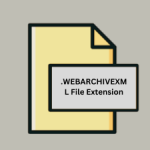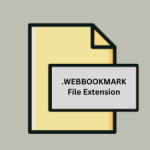.XHTML File Extension

What is an XHTML file?
The .XHTML file extension refers to files written in Extensible Hypertext Markup Language (XHTML), which is a web page format designed to combine the strengths of HTML and XML. XHTML is used to create web documents with a strict syntax that follows XML rules.
More Information.
- Initial Purpose: XHTML was developed to bridge the gap between HTML and XML, making web documents more reliable and easier to maintain.
- History: XHTML 1.0 was first published in January 2000. It aimed to provide a cleaner, stricter standard for web development. Later versions, such as XHTML 1.1 and XHTML 2.0, introduced additional features and improvements but were eventually superseded by HTML5.
Origin Of This File.
XHTML was introduced by the World Wide Web Consortium (W3C) as a reformulation of HTML 4.01 using XML 1.0. The goal was to make HTML more rigorous and to ensure that web documents are well-formed and can be processed by XML parsers.
File Structure Technical Specification.
- File Structure: XHTML files are structured similarly to HTML files but adhere to stricter XML rules. They must have well-formed XML syntax, meaning all tags must be properly nested and closed.
- Technical Specification: XHTML documents must be served with an XML MIME type (such as
application/xhtml+xml) and include a DOCTYPE declaration to specify the version and DTD (Document Type Definition) being used. The content is structured with elements and attributes similar to HTML but with additional XML constraints.
How to Convert the File?
Windows
- To HTML:
- Manual Conversion: Open the
.XHTMLfile in a text editor like Notepad++ or Visual Studio Code. Save the file with a.htmlextension. Ensure the file content is valid HTML. - Using Tools: Tools like
HTML Tidycan convert XHTML to HTML. You can use the command line or integrated features in text editors.
- Manual Conversion: Open the
- To PDF:
- Online Converters: Use online services like Zamzar or Convertio to upload and convert
.XHTMLto PDF. - Desktop Software: Programs like Adobe Acrobat or PDFCreator can convert
.XHTMLfiles if you print the file to a PDF printer.
- Online Converters: Use online services like Zamzar or Convertio to upload and convert
- To DOCX or Other Formats:
- Microsoft Word: Open the
.XHTMLfile in Word and then save it as.docxor another format. - Online Converters: Use services like Zamzar or CloudConvert.
- Microsoft Word: Open the
Linux
- To HTML:
- Manual Conversion: Open the
.XHTMLfile in a text editor like Gedit or Vim. Save the file with a.htmlextension. - Using Tools: Use command-line tools like
tidyto convert the file if necessary.
- Manual Conversion: Open the
- To PDF:
- Online Converters: Use services like Zamzar or PDFCrowd.
- Command Line: Use tools like
wkhtmltopdfto convert.XHTMLto PDF via the command line.
- To DOCX or Other Formats:
- LibreOffice: Open the
.XHTMLfile in LibreOffice Writer and export it as.docxor other formats. - Online Converters: Use services like CloudConvert.
- LibreOffice: Open the
Mac
- To HTML:
- Manual Conversion: Open the
.XHTMLfile in TextEdit or Visual Studio Code and save it as.html. - Using Tools: Use HTML Tidy or similar tools for conversion.
- Manual Conversion: Open the
- To PDF:
- Online Converters: Use services like Zamzar or Convertio.
- Using Preview: Open the
.XHTMLfile in a browser, then use the print function and save as PDF.
- To DOCX or Other Formats:
- Microsoft Word for Mac: Open the
.XHTMLfile in Word and save it as.docxor another format. - Online Converters: Use CloudConvert or Zamzar.
- Microsoft Word for Mac: Open the
Android
- To HTML:
- Manual Conversion: Use a file manager and text editor app to rename the file extension to
.html. Ensure the file content is valid HTML.
- Manual Conversion: Use a file manager and text editor app to rename the file extension to
- To PDF:
- Online Converters: Use mobile web browsers to access online conversion tools like Zamzar or Convertio.
- Apps: Use apps like OfficeSuite or other PDF converters available in the Google Play Store.
- To DOCX or Other Formats:
- Online Converters: Access online conversion tools like Zamzar from the mobile browser.
- Apps: Use apps that support document conversion if available.
iOS
- To HTML:
- Manual Conversion: Use a file management app and text editor to change the file extension to
.html. Check that the content is compatible with HTML.
- Manual Conversion: Use a file management app and text editor to change the file extension to
- To PDF:
- Online Converters: Use web-based services like Zamzar or CloudConvert via a browser on iOS.
- Apps: Use apps like PDF Converter or PDF Expert to convert files.
- To DOCX or Other Formats:
- Apps: Use apps like Pages or Word for iOS to open the
.XHTMLfile and export it as.docxor other formats. - Online Converters: Use services like CloudConvert.
- Apps: Use apps like Pages or Word for iOS to open the
Others
- To HTML:
- Manual Conversion: Rename the file extension to
.htmlif the content is compatible with HTML. - Using Tools: Use cross-platform tools like HTML Tidy or online converters.
- Manual Conversion: Rename the file extension to
- To PDF:
- Online Converters: Services like Zamzar or Convertio work across different platforms.
- Desktop Software: Use universal desktop applications that support PDF creation.
- To DOCX or Other Formats:
- Online Converters: Websites like Zamzar, CloudConvert, or other universal file conversion tools can handle these conversions.
Advantages And Disadvantages.
- Advantages:
- Well-formed Syntax: Ensures documents are valid XML and can be parsed consistently.
- Interoperability: Can be processed by both HTML and XML parsers.
- Consistency: Provides a more rigorous standard compared to HTML.
- Disadvantages:
- Complexity: Stricter syntax rules can make it more complex to write and debug.
- Compatibility Issues: Some older browsers or systems may have trouble processing XHTML correctly if served with an XML MIME type.
How to Open XHTML?
Open In Windows
- Web Browsers: Open
.XHTMLfiles with web browsers like Chrome, Firefox, Edge, or Internet Explorer. - Text Editors: Edit with text editors such as Notepad++, Sublime Text, or Visual Studio Code.
Open In Linux
- Web Browsers: Use browsers like Firefox, Chromium, or other Linux-compatible browsers.
- Text Editors: Edit with editors like Gedit, Vim, or Atom.
Open In MAC
- Web Browsers: Open with Safari, Chrome, or Firefox.
- Text Editors: Edit with TextEdit, Sublime Text, or Visual Studio Code.
Open In Android
- Web Browsers: Open
.XHTMLfiles with browsers like Chrome or Firefox. - Text Editors: Use apps like QuickEdit or AIDE for editing.
Open In IOS
- Web Browsers: Use Safari or other browsers like Chrome or Firefox.
- Text Editors: Apps like Textastic or Koder can be used for editing.
Open in Others
Online Tools: Use web-based editors and viewers for viewing or editing .XHTML files.













